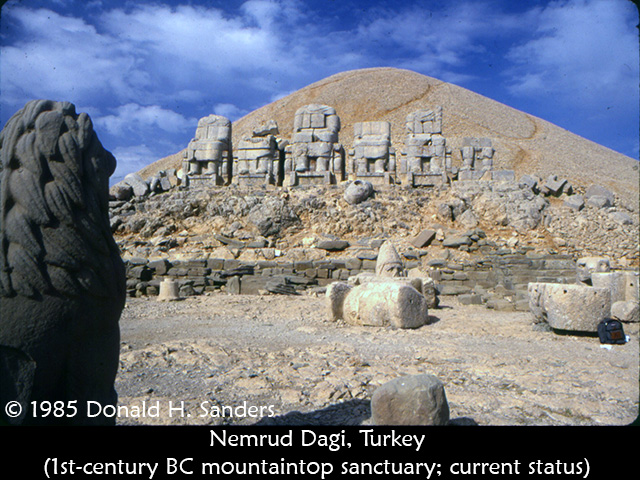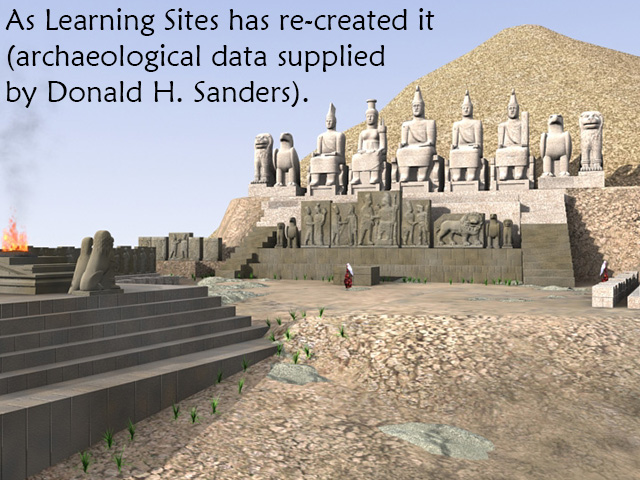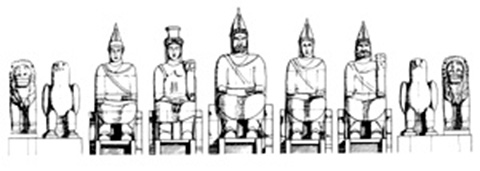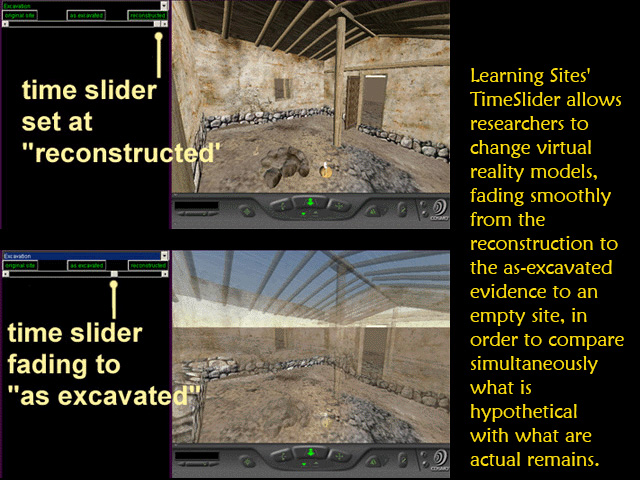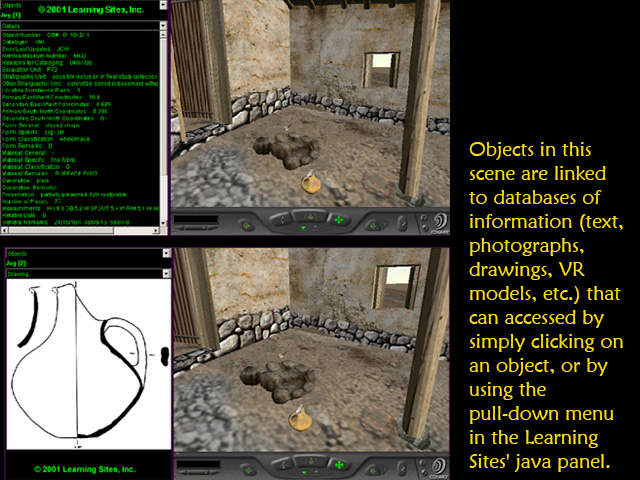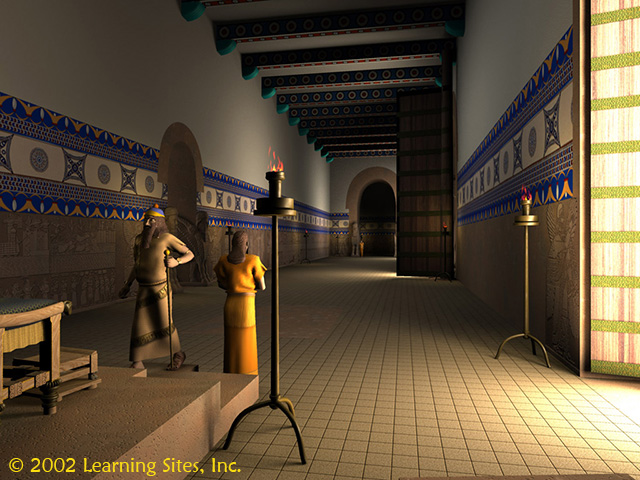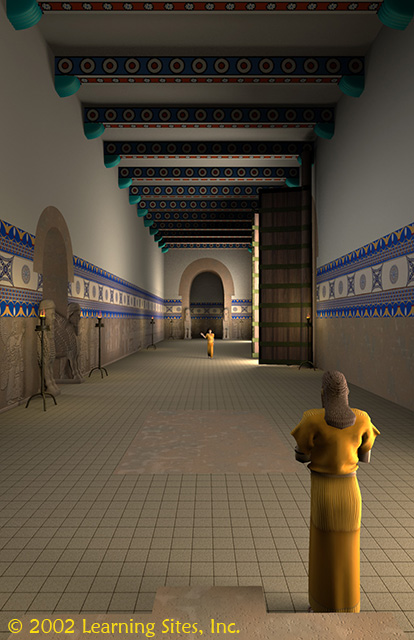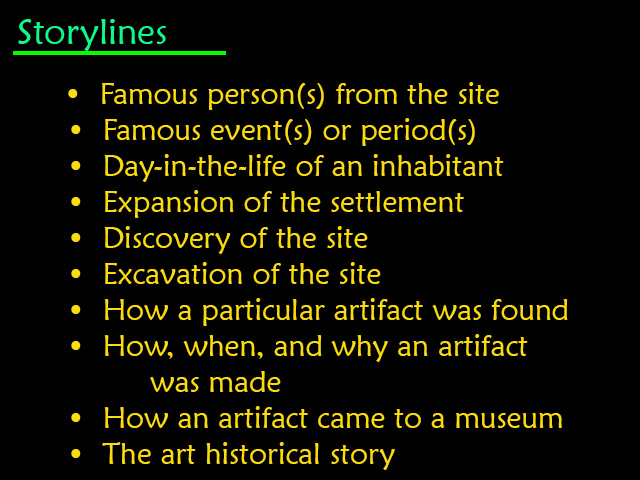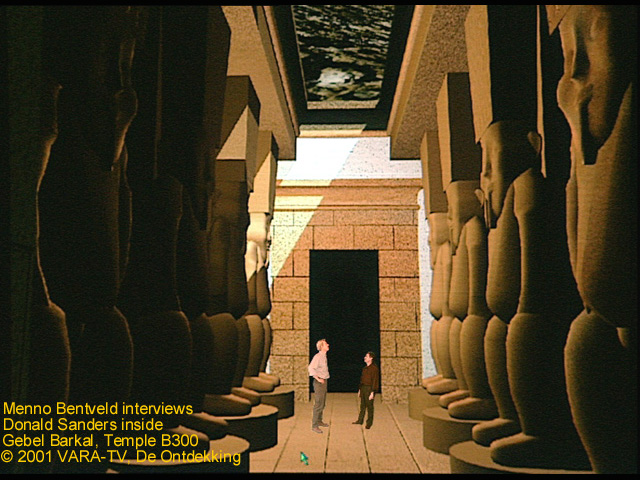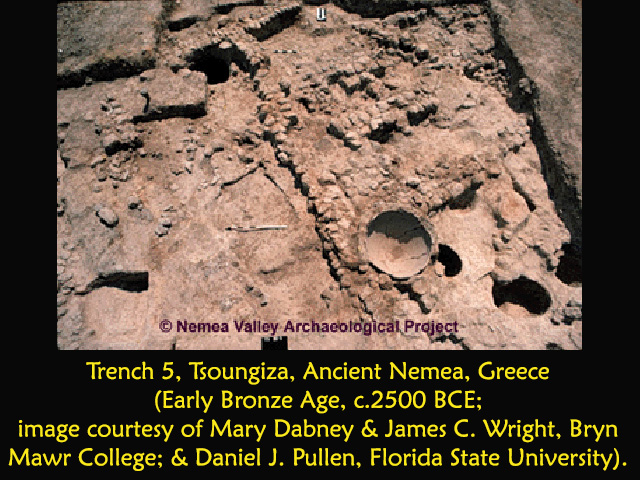 What's it like to visit an archaeological site? Many sites seem little more than scatters of unrelated stones and holes in the ground (see for example the site at the left; hover over to enlarge). Even archaeologists often have trouble interpreting what they are seeing, without supplemental images or descriptions. Most sites offer visitors a paper guidebook containing perhaps a plan or a reconstruction drawing and some history of the different occupation phases of the site. Some sites provide signage with reconstructions of the ruins at specific locations or vantage points. Some sites have interpretation centers providing slide shows or movies to prepare visitors for what they will be seeing. Some sites still use elaborate sound and light shows dramatizing events that made the location famous. But it is difficult to imagine the complexities of history based on isolated images, a few drawings, or summary explanations. It is difficult to see away later walls and understand the full extent of earlier habitations; it is even more difficult to visualize how artifacts might have been used or to envision people actually living and working at the site.
What's it like to visit an archaeological site? Many sites seem little more than scatters of unrelated stones and holes in the ground (see for example the site at the left; hover over to enlarge). Even archaeologists often have trouble interpreting what they are seeing, without supplemental images or descriptions. Most sites offer visitors a paper guidebook containing perhaps a plan or a reconstruction drawing and some history of the different occupation phases of the site. Some sites provide signage with reconstructions of the ruins at specific locations or vantage points. Some sites have interpretation centers providing slide shows or movies to prepare visitors for what they will be seeing. Some sites still use elaborate sound and light shows dramatizing events that made the location famous. But it is difficult to imagine the complexities of history based on isolated images, a few drawings, or summary explanations. It is difficult to see away later walls and understand the full extent of earlier habitations; it is even more difficult to visualize how artifacts might have been used or to envision people actually living and working at the site.
By the end of this conference, we will have learned many new methods of informing the public so they can understand the nuances of everyday life of an ancient and foreign culture. Many new technologies have come available in the past few years for use in site museums or at archaeological parks to help display artifacts, to inform visitors, and provide background contexts for the history of the place. Some of these technologies use computer graphics, such as, animations, photobubble panoramas, object movies, and augmented reality. Each has its place in dramatizing history; in engaging visitors; and telling stories; providing visitors with surrogate or virtual realities--to transport us to places and situations we could never otherwise appreciate.
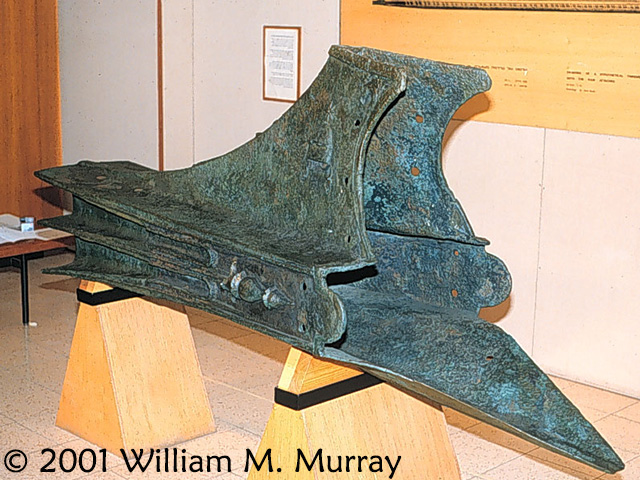 So, imagine this: You arrive at a museum or interpretation center and acquire a handheld device to carry with you into the galleries. From its computer screen you select the object displayed before you (for example, the Athlit ram, a bronze Roman-era ramming prow, at the left; hover over to enlarge) and then the storyline that you wish to pursue. The small but very high resolution color screen shows you the object as it would have looked when it was new (see the interactive model below; use the left mouse button and mouse to rotate and zoom).
So, imagine this: You arrive at a museum or interpretation center and acquire a handheld device to carry with you into the galleries. From its computer screen you select the object displayed before you (for example, the Athlit ram, a bronze Roman-era ramming prow, at the left; hover over to enlarge) and then the storyline that you wish to pursue. The small but very high resolution color screen shows you the object as it would have looked when it was new (see the interactive model below; use the left mouse button and mouse to rotate and zoom).

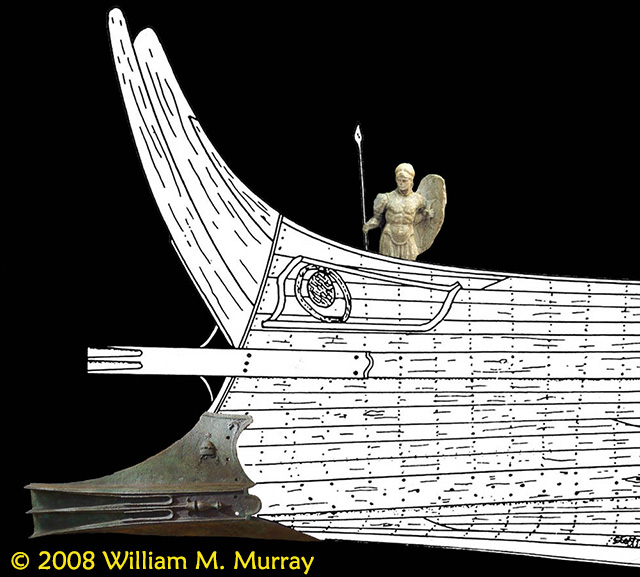 Depending on the storyline you've selected, it might also show you the object in its original context (see the mockup at the left; hover over to enlarge), or as it was unearthed during excavation, or in comparison with others of its type. As the linked voiceover informs you about the object, it also refers you to the screen where you can select additional text or images or make other choices depending on what sort of information interests you.
Depending on the storyline you've selected, it might also show you the object in its original context (see the mockup at the left; hover over to enlarge), or as it was unearthed during excavation, or in comparison with others of its type. As the linked voiceover informs you about the object, it also refers you to the screen where you can select additional text or images or make other choices depending on what sort of information interests you.
Similarly, imagine that you arrive at an archaeological site and go first to the Visitors' Center for orientation. Afterwards you're given a hand-held device to carry with you onto the site. From its computer screen you choose a storyline to follow as you explore the site. Perhaps you select "A Day in the Life" of an ancient inhabitant. The screen then shows you a 3D computer reconstruction of the site as it would have looked in ancient times, the model's position calibrated for the exact spot at which you are located; a narration then guides you around the site's remains through a story of yourself as an inhabitant. Having completed that tour, you might begin again, this time selecting the "Excavation" storyline. As you move around the real site this time, the screen shows you a digital re-creation of your exact location as it looked when rediscovered by archaeologists and at various stages of its excavation. At any time during your tour, you may access linked texts and photographs for more background information about any related artifact, site feature, or person.
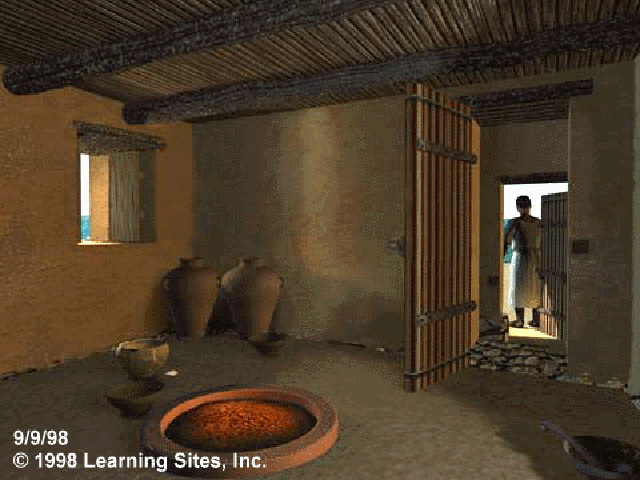 I will be speaking today about some of the advantages of using 3D computer graphics to impart alternate realities for visitors to archaeological sites and museums; of providing visitors with portholes to the past. But supplying them with more than pretty pictures, instead with engaging adventures, personalized experiences, and multiple interpretations of the remains strewn before them (see the digital reconstruction of the Early Bronze Age House at Tsoungiza, Ancient Nemea, Greece; c.3200 BC; archaeological data supplied by Daniel J. Pullen, Florida State University; hover over to enlarge). The virtual realities become magical, creating an atmosphere in which anything is possible.
I will be speaking today about some of the advantages of using 3D computer graphics to impart alternate realities for visitors to archaeological sites and museums; of providing visitors with portholes to the past. But supplying them with more than pretty pictures, instead with engaging adventures, personalized experiences, and multiple interpretations of the remains strewn before them (see the digital reconstruction of the Early Bronze Age House at Tsoungiza, Ancient Nemea, Greece; c.3200 BC; archaeological data supplied by Daniel J. Pullen, Florida State University; hover over to enlarge). The virtual realities become magical, creating an atmosphere in which anything is possible.
I am not going to talk about the various methods used to deliver the digital images, that will be covered by others, but a bit about how we can use various 3D computer graphics techniques to tell stories, inform visitors, provide educational, engaging, exciting and memorable experiences in ways not possible with traditional visualization modes or media; in ways that can supplement and enhance other themed events and techniques; with goal of offering visitors a glimpse into what happened at the site, who some of the ancient inhabitants were, and why visitors should return again and again.
Several computer-based visualization formats are increasingly becoming part of the archaeologists' arsenal for the collection, study, and dissemination of excavated data. So, too, can these same display modes become part of the site or museum visitors' source of information about a place, time, object, or person.
Once the precise, accurate, and detailed 3D computer models have been built (and have been checked by archaeologists or other experts), there are several possible output visualization types. For example, there are computer animations (such as at the left; the king ascending to his throne in the Northwest Palace, Nimrud; archaeological data supplied under the direction of Samuel M. Paley, University at Buffalo, SUNY). These are like short movies in that they are linear presentations, there is no user interaction, and there can be voiceovers, sounds, or overlying explanatory text. These are created by having the computer render out a sequence of single images (snapshots of the 3D model as the camera moves along a preset path), similar to the individual frames of a movie or the single cels of a hand-drawn animated cartoons.
Then, there are QTVR movies or panoramas, that either play by themselves, like animations, or require the viewer to navigate by moving around in a circle, as if standing in the center of a bubble the surface of which is covered with flat images of the scene. QTVR navigation is programmed to give the impression that you can look everywhere. But since there is no real 3D space, you cannot walk around, or look behind anything, because your viewpoint is fixed at the center of the bubble (see, for example, the panorama below from our model of the Lion Gate, Til Barsib; left click and use your mouse to rotate and zoom; ed. note 2019: the original presentation used QTVR to display the panorama, but that format is no longer supported by browsers, so we recoded the panorama to run using WebGL/HTML5).
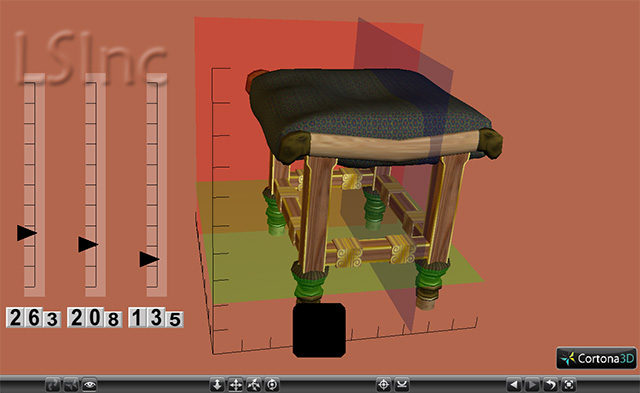 In contrast, true virtual reality is a digital surrogate of actual 3D space, allowing the viewer to explore an entire scene, look anywhere, go anywhere, and examine objects closely on all sides (at the left is a screen grab from Learning Sites innovative virtual reality object measurement tool; hover over to enlarge; ed. note 11/2019: the presentation showed this tool in action using VRML, which is no longer supported in current browsers). Since this is a simulated environment you can do anything you can in a real space, and some things you can't, because in VR the laws of physics are optional. Virtual environments can be further enhanced with sounds, animated characters, and the ability to feel objects in the virtual space.
In contrast, true virtual reality is a digital surrogate of actual 3D space, allowing the viewer to explore an entire scene, look anywhere, go anywhere, and examine objects closely on all sides (at the left is a screen grab from Learning Sites innovative virtual reality object measurement tool; hover over to enlarge; ed. note 11/2019: the presentation showed this tool in action using VRML, which is no longer supported in current browsers). Since this is a simulated environment you can do anything you can in a real space, and some things you can't, because in VR the laws of physics are optional. Virtual environments can be further enhanced with sounds, animated characters, and the ability to feel objects in the virtual space.
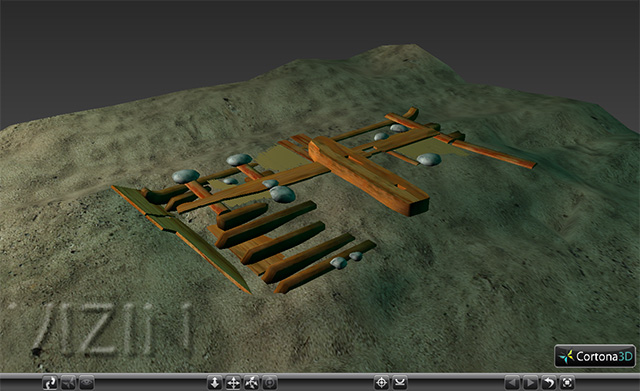 For buildings or sites, this type of sensory-laden visualization allows visitors to explore at their own pace, see, hear, and touch things in ways that come very close to a first-person experience, to actually being there (at the left is a screen grab from the virtual re-creation of the Tantura Harbor, Trench X, shipwreck; archaeological data supplied by Shelley Wachsmann Texas A&M University; hover over to enlarge; ed note 11/2019: the original virtual world was shown using VRML, which is no longer supported in current browsers; we are working to upgrade old virtual worlds into the newest WebGL/HTML5 code).
For buildings or sites, this type of sensory-laden visualization allows visitors to explore at their own pace, see, hear, and touch things in ways that come very close to a first-person experience, to actually being there (at the left is a screen grab from the virtual re-creation of the Tantura Harbor, Trench X, shipwreck; archaeological data supplied by Shelley Wachsmann Texas A&M University; hover over to enlarge; ed note 11/2019: the original virtual world was shown using VRML, which is no longer supported in current browsers; we are working to upgrade old virtual worlds into the newest WebGL/HTML5 code).
Reliance on these types of interactive computer environments for all aspects of archaeological investigation is the basis of the new fields of Virtual Archaeology and its broader concept, Virtual Heritage. These new disciplines incorporate virtual reality into their inquiries about the past, for teaching, interpreting site remains, visualizing alternative reconstructions, publishing reports, and creating massive research resources. Learning Sites was among the pioneers of Virtual Archaeology back in the early 1990s and continues to be one of its leading proponents and innovators. Virtual reality is an ideal visualization and storytelling technique for archaeological sites and museums, because it can so artfully evoke any time period or situation visitors may be interested in learning more about.
